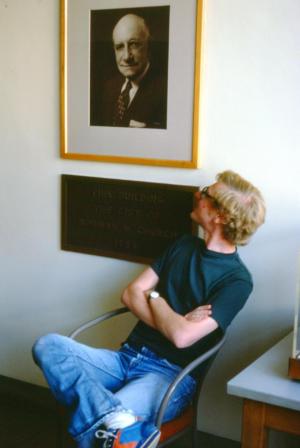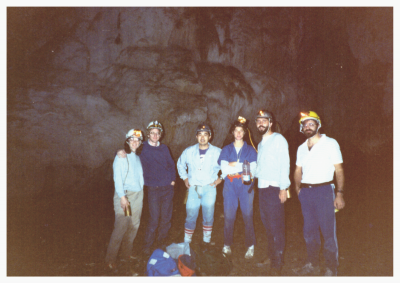Matt Hartman

When a professional journal in your field dedicates an entire issue to reviewing your life’s work, you have a unique opportunity to look back on your career.
“I can’t believe I’m as old as I am,” said David Beratan, who recently had that experience when the Journal of Physical Chemistry B published a special issue in honor of his 60th birthday. “It’s a privilege, an honor. It’s flattering and a little bit embarrassing.”
Of course, not everyone gets this treatment, however long their careers. Beratan, the R.J. Reynolds Distinguished Professor of Chemistry, has impacted his field in ways that are “both extraordinarily diverse and profound,” the issue’s guest editors wrote, including “a broad and deep impact on chemistry, biochemistry, and biophysics.”
But Beratan sees things in more personal terms. “I was struck by how human an activity science is,” he said. “Many of the choices of problems I went after were defined by the people around me.”

Born to a teacher and a professor, Beratan was interested in science from an early age. When he came to Duke as an undergraduate student in 1976, he quickly found his way into what would become his lifelong field: theoretical chemistry. He began lab work in the cutting-edge quantum chemistry of the time, as well as numerical analysis.
Later, during his doctoral training at Caltech, Beratan began focusing on electron-transfer theory—one of the topics he still works on today. He then spent five years working at NASA’s Jet Propulsion Laboratory, examining the way electron transfer works in biological systems. But the draw of teaching was great, and Beratan jumped at an opportunity to join the faculty at the University of Pittsburgh in 1992.
After 10 years of innovative teaching and research, Beratan reconnected with colleagues at Duke during his 20th college reunion. That connection turned into a faculty offer. Excited about a growing department with a renewed interest in cross-disciplinary research, Beratan rejoined his undergraduate institution.
Across all of those career stops, Beratan’s research has focused on two unifying themes, both of which center on the electron.
The first is the chemical origins of useful properties found in “reasonably complex” molecules. “I’ve always been interested in the origins of function, or what biologists might call emergent properties—in how function arises from structure,” Beratan said.
Biological electron transfer, or how electrons move through biomolecules, is one example—particularly their interactions with oxygen. Humans extract energy from electrons, taking as much as we can before getting rid of the depleted particles, Beratan explained. We breathe oxygen because it’s a strong acceptor of those discarded electrons, which attach to the oxygen molecules.
Understanding the precise mechanisms that enable those transfers may help scientists develop useful new technologies. Beratan is developing those theories by studying certain bacteria that also respire with oxygen, but which have evolved a trick to avoid dying when the molecule isn’t available. “What they do is grow little appendages that are about as big as their cells,” Beratan said. “They’re conduits for electrons to flow, and the bacterial cells will look for minerals like iron oxide to use as terminal electron acceptors instead.”

The second theme in Beratan’s work is the quantum mechanical nature of matter, especially in the behavior of electrons.
“The glue that holds everything together in chemistry is the electron,” Beratan said. “But it has dual characteristics—sometimes it acts like a wave, sometimes it acts like a particle. How these effects arise from the electrons in a molecule and what causes these behaviors to manifest is at the core of chemistry.”
The wave-like characteristics are fleeting, but when they occur, it’s possible to use them to do things that seem exotic and unexpected from our daily, macroscopic experience. “We’re trying to understand if we can use them in order to modify the way chemical reactions occur,” Beratan said. For instance, leveraging the wave-like behavior may allow chemical reactions to take place at cooler temperatures, with implications in energy science and catalysis.
“Our research has enabled us to understand how, at the level of electrons and atoms, cells manipulate and use energy. It’s one of the most fundamental features of the cell. It’s understanding how the power plant of the cell works.”

As fundamental and as influential as his theories have been, Beratan said they aren’t the most important element of his work. “The biggest impact we’re going to have is not by the papers we publish, but the students we train,” he said.
Beginning in Pittsburgh, Beratan has experimented with new ways of teaching physical chemistry, combining emerging technology—he began using computers in the classroom to do real-time calculations and visualizations in the early 1990s—with educational models like the “flipped classroom,” which create a more active learning environment. He has also co-taught online courses with research collaborators from around the country in an effort to offer classes on special topics that might otherwise not take place.
The emphasis on mentorship and collaboration is evident in Beratan’s approach to chemical theory, too. “I’m problem-driven,” he said. “I’m very interested in identifying the most compelling questions coming out of the experimental groups that I can address with theories.” As a result, he has created a much-needed feedback loop between theoretical developments and experimental findings. And those relationships have turned into decades-long collaborations and friendships. One example is Michael Therien, Duke’s William R. Kenan, Jr. Distinguished Professor of Chemistry and one of the guest editors of the Journal of Physical Chemistry B issue devoted to Beratan’s career. The two chemists met when Therien, then a postdoc, visited the Jet Propulsion Laboratory during Beratan’s tenure there.
Beratan’s ongoing work is continuing in the same vein. He now runs the Center for Synthesizing Quantum Coherence, a National Science Foundation–funded project, with Therien and chemists from Northwestern University, University of California – Berkeley, and the University of Illinois Urbana-Champaign. Not only does the center continue Beratan’s already influential research and deepen his collaborative relationships, but it aims to have “a broader impact on society by developing novel schemes for cross-disciplinary student training, driving innovation, enhancing science communication skills of its participants, and contributing to a diverse STEM workforce.”
After more than 30 years of that approach, it’s no wonder his colleagues honored him in print.